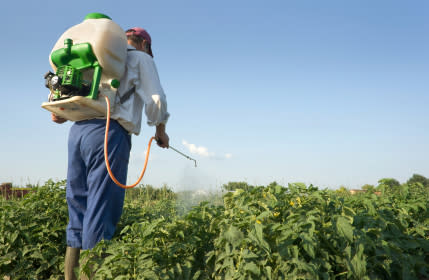DDT – Persistent Pesticide Still a Threat
By Toni Salter

Although DDT has not been used in the U.S. since 1972, traces have been found in human breast milk, even today. That is not to say that you should stop breastfeeding. On the contrary, breastfeeding is the best possible nourishment, however you should be aware of the potential sources of this deadly pesticide that still exist.
Besides, if DDT is in human breast milk, it most certainly can be found in cow's milk. DDT (Dichlorodiphenyltrichloroethane) is a banned organochlorine pesticide used heavily from the 1960's up to and including the 1980's in some western countries. Originally used to treat malaria and typhus during wartime years, DDT was then later used to kill insects on agricultural crops.
A Shopper's Guide to Pesticides in Produce
How to Use Pesticides Safely in Your Garden
The persistent nature and bioaccumulation of pesticide residue was only detected some time after mass worldwide use had occurred. This pesticide has been associated with numerous harmful health issues including, neurotoxicity, reproductive disorders, lowered levels of immunity and cancer. [1]
As a result of the public exposure brought about by American scientist, Rachel Carson in her landmark book Silent Spring, the pesticide was banned and deregistered for agricultural use. DDT was banned in Norway, Sweden the US in the early 70's, however the UK and Australia continued to use DDT until well into the 1980's. Mainland China also used the pesticide heavily until the late 1980's.
Restricted use can still occur for certain hazardous insect outbreaks, particularly for extreme risk of malaria. Bioaccumulation of the pesticide means that the residue builds and it moves throughout the food chain. DDT and its metabolites are stored in the fatty tissue of animals, including people and leaves the body very slowly.
How to Effectively Deal with Pests in your Vegetable Garden
Top Strategies for Building a Compost Pile
Concern arises when studies have shown continued environmental contamination in certain areas of Hong Kong and China as water samples taken from rivers show adverse levels present. [2] This serves as a reminder that we should be aware of the source of our fresh produce.
Countries exhibiting high past usage of organochlorine pesticides like DDT can still exhibit adverse levels of residue in soil currently growing produce that may be exported to countries including Australia, America and the UK.
Certain fruits and vegetables can still contain traces of DDT. Foods that are most likely to have higher bioaccumulation levels include fish, poultry, beef and dairy.
The best choice is to buy plant based products at local produce or farmers markets, where you can talk with growers directly. Most will know the history of pesticide use on their land and are willing to share this information along with soil sampling test results.
If growers are dismissive when questioned, then perhaps they don't know this information or worse, maybe they don't want you to know.
Toni Salter, 'The Veggie Lady', is an Australian registered horticulturist living in Sydney. Follow Toni on Twitter and 'Like' her on Facebook
[1] http://www.inchem.org/documents/jmpr/jmpmono/v00pr03.htm#_00031000 [2] Hui et al., DDT levels in human milk in Hong Kong (2008)
More from ecomii:
